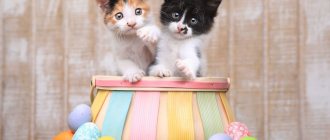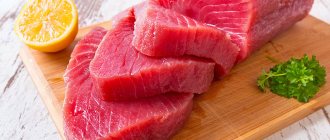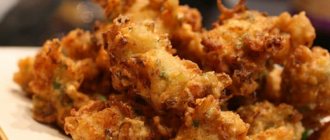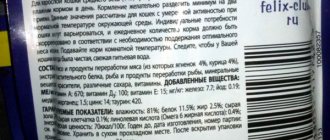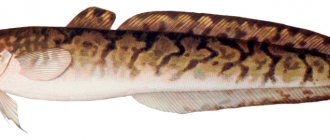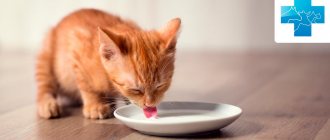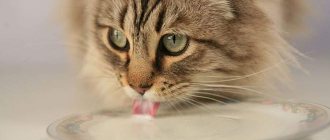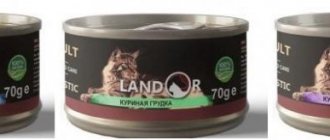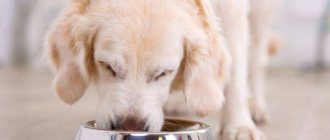What can I replace it with and can I make it myself?
- Fact 1:
For the most part, cat milk contains the same components as any other milk. - Fact 2:
There are more than three dozen manufacturers of artificial cat milk in the world - Fact 3:
Unfortunately, having taken on such a responsible task, many manufacturers were unable to recreate the formula of cat milk as accurately as possible. - Fact 4:
Buying a real formula is great, but without following the right rules, you can harm your pet.
The nature of cats is very gentle. As soon as the kittens are born, they immediately need milk. Therefore, the wise organism of the mother cat begins to prepare for this important process in advance. Even before birth, special structures of the body begin to produce colostrum (“young” milk), which is of vital importance for newborn babies. As soon as the kittens are born and attach themselves to the cat, along with colostrum they receive a “vaccine” against dangerous infections. This is practically the foundation for the kitten’s future immunity, which is laid in the first 24 hours after birth.
But tragedies happen when a mother cat dies during labor (or after childbirth), or for good reasons is unable to feed her offspring. Sometimes cats don't have milk. In such an extreme situation, all responsibility for the cubs falls on the shoulders of the owner. He only has a day to find a replacement for cat milk. Despite the fact that colostrum has a unique composition that cannot be replaced by any chemical formula, there are several alternatives to this miraculous liquid. And every cat owner should remember them.
Composition and nutritional value of milk
The drink mainly consists of water: it occupies up to 88% of the total mass.
It contains 4.7% carbohydrates, 3.2% fats, and 2.9% proteins. There is no fiber in the composition. The average calorie content of 100 ml of milk is 60 kcal, but the figure may vary depending on the fat content of the product and its variety. For example, mare's milk is considered dietary. Milk contains almost all the vitamins and minerals discovered by mankind. However, the proportion of some compounds is small. This applies to phylloquinone, ascorbic acid, molybdenum and fluorine.
The drink contains relatively many of the following substances:
The drink contains a lot of retinol and potassium.
- retinol;
- riboflavin;
- thiamine;
- pantothenic, nicotinic acids;
- choline;
- cobalamin;
- pyridoxine;
- biotin;
- potassium;
- sodium;
- magnesium;
- calcium;
- chlorine;
- chromium;
- phosphorus;
- iodine;
- cobalt
Expert opinion
Milk can be given to kittens up to 3-4 months inclusive. Further, it is better to eliminate this product from the diet, which is associated with insufficient production of enzymes in the body of an adult cat necessary for the absorption of lactose.
It is unacceptable to combine milk with industrial feed, as this food will contribute to the formation and deposition of kidney stones. Urolithiasis for cats is a rather dangerous condition, often leading to death. Is it worth the risk?
An excellent alternative for diversifying the daily menu is tasty and healthy fermented milk products without sugar and various fruit fillings. The optimal solution: kefir, sour cream, natural yogurt, fermented baked milk and cottage cheese (all products should have a small percentage of fat content). It is better to serve sour cream diluted with clean boiled water.
It is unacceptable to feed your domestic cat salty and hard cheeses, curds, sweet cheeses with various fillings and store-bought yoghurts.
It is advisable to prepare a healthy breakfast for your beloved pet yourself, without adding sugar or other sweetening ingredients (for example, honey or jam). It is better to leave your furry friend without a sweet treat than to later reap the consequences of poor nutrition for animals.
Important: all fermented milk products in your pet’s diet must be fresh!
So, now you know for sure whether kittens can be given cow’s milk and what is the best way to replace this unsafe product in the diet of a growing animal. Soon we will definitely discuss another, no less exciting question - whether it is possible to give domestic cats raw meat, which is also the favorite delicacy of the small predator.
Only a properly developed diet will allow you to maintain the health of your beloved cat for many years, which will accordingly prolong its happy and carefree life in your family!
Useful properties for cats
In small quantities, the drink supports the health of bone tissue and muscles, and prevents the development of diseases of the musculoskeletal system. The treat accelerates the growth of kittens and promotes the final formation of the spine and joints. Calciferol in the product helps to correctly absorb calcium, strengthens bones and teeth.
Milk improves digestion and maintains muscle health.
The drink improves muscle activity and prevents the appearance of chaotic spasms. In addition, it improves digestion and stabilizes heart rate. The risk of vascular pathologies is reduced and blood circulation is normalized. All organs and tissues receive more nutrients, which has a beneficial effect on the general condition of the animal.
Treats in limited quantities prevent the development of obesity. The product contains protein, which contributes to the formation and maintenance of the muscle corset. The latter burns calories even at rest.
However, this does not apply to animals that lead a sedentary lifestyle and overeat. In their case, the product will become an unnecessary addition to the menu.
Veterinarian advice
Feeding kittens is an incredibly responsible process. The future health of your children will depend on the correctness of your actions. Experienced veterinarians offer the following tips for proper feeding of newborn kittens:
- Be sure to weigh your pets daily. Each deviation must be accompanied by an appropriate reaction.
- Sterilize utensils thoroughly after use.
- Do not keep an open bag of food for more than a month.
- Starting from the 8th day, the baby should be fed with vitamin mixtures in liquid form.
It is best to discuss the use of additional supplements in this case with your veterinarian.
What kind of milk can you give your pet?
The body’s reaction depends on the choice of milk type, since their composition is different. To minimize risks, you additionally need to take into account the age and individual characteristics of the pet. Homemade milk should be avoided: it does not pass quality checks, is not subject to additional heat treatment and contains more fat. An animal can become infected after eating such a treat. Homemade milk is given to a pet only if the quality of the drink is beyond doubt.
Cow
It is affordable and can be purchased at most stores. The drink has a balanced composition. However, cow's milk contains relatively high amounts of lactose. This increases the risk of developing intolerance, since in most cases the occurrence of allergies is associated with this substance.
Cow's milk contains a lot of lactose.
Goat
Goat's milk is preferable for the cat's body. It is relatively low in lactose. This reduces the risk of allergies. However, even this can provoke intolerance, so the treat should be offered with caution and monitor the animal’s reaction.
Substitutes
Cat milk replacer is used to feed small kittens. The product is a concentrated powder that must be diluted with liquid in the proportions specified by the manufacturer. This is the most suitable food for kittens left without a cat. It is not recommended to give adult animals a substitute and products based on it. This is due to its concentrated composition.
Substitutes are used for small kittens.
Impact factors
The fat content of cow's milk is influenced by many factors. At first glance, an unpretentious animal needs proper care, adherence to feeding principles and the study of individual characteristics. For example, you cannot expect a lot of milk from a meat cow.
Alternatively, the difference between homemade and store-bought milk is one of the types of processing listed above. Sometimes the fat content of homemade liquid is unknown, because it can be accurately determined in production. And drinking untested fresh milk is fraught with digestive disorders and other consequences. Therefore, they often talk about its excessive fat content.
Genetics
Genetic predisposition and the breed of the animal play an important role in the problems of increasing the fat content of milk. For many years, breeders have worked to develop a cow that will have both high milk yield and fat percentage. But if owners of cows increase milk yield, this helps reduce fat content. Also, in the process of increasing the fat content of cow's milk, the volume of lactation decreased.
As a result, the following cow breeds showed the best results:
- Jersey with the highest record of 14 percent and an average of 5. They have low milk yields, so they are kept one or two in small farms;
- Red Danish with a fat content of 5.1 percent;
- Simmental, the maximum fat content of which reached 4.85 percent.
In Russia, the Yaroslavl breed (4.15 percent) achieved the greatest results in terms of fat content of cow's milk, followed by the Kholmogorskaya (3.97) and Kostromskaya (3.92). The worst indicators are for the black-and-white and red steppe species of cattle. Their fat component is noted at 3.3 percent. These are average values.
However, they live up to expectations regarding high milk yield and total fat content. Therefore, they remain popular among livestock breeders. Fat-dairy cattle are in demand, but rather in isolated cases, not for breeding herds.
Although genetics plays a role in most animal traits, milk fat content is determined by other, more significant factors. Cow's milk is significantly affected by:
| № | Helpful information |
| 1 | feed and its quality |
| 2 | Burenka's age |
| 3 | conditions of detention |
Nutrition
Many owners of large and small farms are scratching their heads about how to increase the fat content of milk. The right place to start is with nutrition. Food affects the quantitative characteristics of milk yield, the taste, color and smell of homemade milk.
Fattier milk is obtained if the cow consumes:
- clean, high-quality hay of legumes and cereals. If the rate of hay produced is reduced, the fat content drops by half a percent;
- food should be rich in fiber, which serves as a source of nutrients;
- light carbohydrates, sugar is needed for the rumen (part of the proventriculus), but not more than ten percent;
- vitamins calcium, zinc, vitamin E, phosphorus, vitamin A.
Green mass, rapeseed hay, and beet pulp have the opposite effect. In spring and summer, cows need to be grazed so they spend most of their time outdoors. The growth of milk yield and the fat content of a cow’s milk increases due to the variety of plant foods.
The main thing is that no moisture gets on it and there is no rot. Porridge with boiled potatoes, pumpkin, zucchini, grass flour, and silage will work during the cold season. You need to be careful with concentrated feeds and avoid overdosing.
Compatible with cat food
Cats require different enzymes to digest different types of food.
For this reason, combining milk with cat food at the same time is not recommended. At best, this will lead to digestive disorders. In the worst case, metabolism will be disrupted, pathologies of the liver and kidneys will occur, and stones will appear in the urinary system. You cannot combine food with milk in 1 meal. If we are talking about general compatibility, taking into account the division of products into different feedings, then combining milk with granules is also undesirable. Manufacturers of ready-made food try to balance the composition to suit the needs of the animal. It is assumed that the pet will receive only dry food: other products are not taken into account. Drinking milk against this background will cause an imbalance.
Another problem is gastrointestinal disorders due to the abrupt inclusion of the product in the menu.
Milk should be given separately from cat food.
If a cat eats pellets for years, its gastrointestinal tract gets used to digesting the food.
About the rules for storing food for kittens
Kittens can be fed only warm formula, the temperature should be about 39° C. Unfinished formula can be kept in the refrigerator for a day in a clean container.
Vitamins for cats against hair loss - expert reviews, the best complexes, products and nutritional supplements for cats (135 photos and videos)Classes of cat food - classification, comparison and detailed overview of the composition (85 photos and videos)
Can cats have eggs - boiled, raw eggs and tips on their use in the diet for cats (110 photos)
The dry mixture should be stored in a cool, dark place away from sources of moisture, and diluted only with boiled water at room temperature, and heated for feeding.
The kitten’s immune background is unstable; its gastrointestinal tract should not be exposed to bacterial attacks. And like a child or kitten, you can cook food only with clean hands.
Rules for consumption and introduction into the animal’s diet
The substitute is given to small kittens, following the instructions provided by the manufacturer. Whenever possible, cow's milk is not offered to pets. If necessary, introduce a product into the menu of an adult animal, start with small portions due to the high development of intolerance. As cats age, their bodies stop producing the enzymes needed to break down milk. This leads to the development of allergies.
Daily norm
It is equal to 10–15 ml per 1 kg of weight for an adult animal. Before feeding, the drink is warmed to room temperature. The norm is indicated for milk with a fat content of 2.5%. If the product contains more lipids, the serving size should be reduced.
The daily norm is 10–15 ml per 1 kg of weight.
Restrictions
It is not recommended to give milk to an animal every day. This is done no more than 2-3 times a week. The product is introduced into the menu with caution. First, the pet is offered a small portion - only 2-3 ml. The reaction is then monitored. If the animal feels normal, the portions are gradually increased to standard.
Frequency of feeding
During the first week, babies are fed every 2-3 hours during the day to avoid various diseases and to strengthen the body. Then gradually reduce feeding at night, bringing the feeding interval to 5 hours in the second week. At week 3, when the kittens begin to see, feeding at night is stopped (from 24:00 to 6:00 am). After 4 weeks, they proceed to the feeding process according to the usual schedule.
We invite you to read: Training a Thai Ridgeback in Moscow with a dog handler
The kitten may refuse further food intake due to the fact that he generally eats little. Sometimes this is associated with some kind of disease. If you have any doubts, consult your veterinarian.
If the baby's tummy is large and dense, you should stop feeding after feeding the required portion. The animal may not feel full and therefore continue to eat.
Precautions and possible harm
As cats lose the ability to digest milk as they age, they may develop intolerance.
It manifests itself in the form of nausea, vomiting and severe diarrhea. The animal often licks itself, may experience increased thirst, becomes lethargic and refuses to play. In the future, in the absence of help, dehydration occurs and the likelihood of developing gastrointestinal pathologies increases. If symptoms of intolerance appear, it is necessary to put the animal on a starvation diet for 1-2 days and provide it with plenty of fluids, since the pet’s body loses a lot of fluid. Not eating for a short period will not cause harm. Fasting will help the gastrointestinal tract rest and recover. Subsequently, the animal is gradually returned to its previous diet. First, he is given gentle foods that strengthen the stool, such as rice and its decoction. Subsequently, low-fat broths and beef are introduced. The transition to a normal diet takes a week.
Fat to protein ratio
The fat and protein levels in milk must be in a certain ratio to each other. A ratio of 1.1:1 to 1.5:1 indicates balanced feeding.
A fat to protein ratio of more than 1.5, especially at the beginning of lactation (except for the colostrum period), is a warning signal. High fat content is a sign of very strong mobilization of fat from the body. Low protein content indicates a lack of energy, although some of the energy comes from the body's reserves. The consequence of this may be metabolic disorders (ketosis).
If the fat to protein ratio is greater than 1.5 throughout lactation, this indicates a structure-rich but energy-poor feeding. Especially with poor quality bulk feeds and a lack of concentrates. The consequence of this is low milk productivity and low protein content in milk
A very low fat to protein ratio (below 1.1) occurs with a diet that is high in energy and low in structure (lots of concentrates). In this case, it is necessary to correctly distribute the feed in accordance with productivity.
We suggest you read: How to find out that a pig has gone on a spree, how many days and at what age
When interpreting the ratio of fat to protein in the first third of lactation, it is necessary to take into account that both the threat of ketosis (with a high indicator) and the threat of rumen acidosis (with a low indicator) are possible. In this case, the “normal” fat to protein ratio may be misleading. Therefore, careful monitoring of animals during this period is necessary, and perhaps even individual collection and analysis of data for animals up to the 30th day of lactation.
To identify feeding errors throughout the year, you can analyze the fat and protein levels of the collected milk monthly. For example, if fat and protein values decrease in early May, this may indicate that there was insufficient structure when transitioning to pasture or that the transition was made very abruptly.
Photo: Data from control milkings provide valuable information for monitoring animal nutrition and health and should be actively used by specialists in each enterprise.
